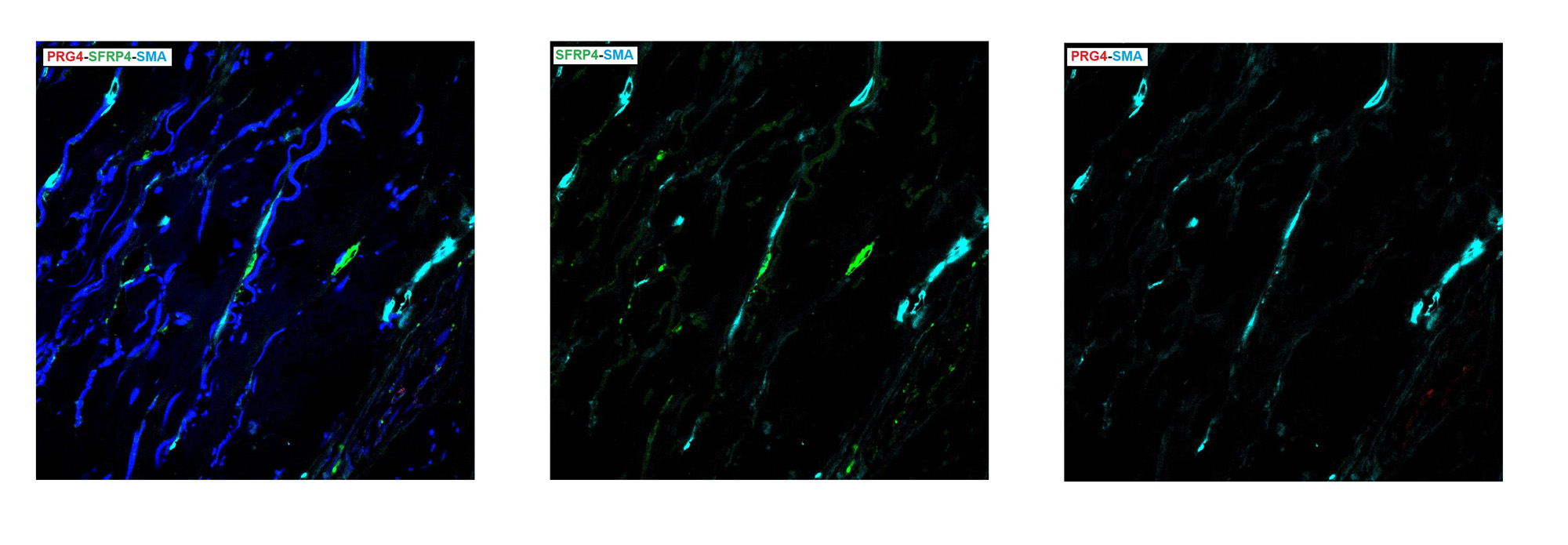Session Information
Date: Tuesday, November 14, 2023
Title: (2352–2369) Systemic Sclerosis & Related Disorders – Clinical Poster III: Translational Science
Session Type: Poster Session C
Session Time: 9:00AM-11:00AM
Background/Purpose: Systemic sclerosis (SSc) is a debilitating autoimmune disease characterized by extensive fibrosis affecting multiple organs. The fibrosis arises from the excessive production of collagen by dysregulated myofibroblasts. Our recent single cell RNA-sequencing (scRNA-seq) studies have described several fibroblast subpopulations in the skin of SSc patients. We have previously shown that myofibroblasts derive from one of these populations that expresses secreted frizzled-related protein 2 (SFRP2) and DPP4, the most common subpopulation of dermal fibroblasts¹. As these cells differentiate into myofibroblasts they show upregulated expression of another gene, secreted frizzled-related protein 4 (SFRP4). However, SFRP4 is also expressed by another fibroblast subpopulation found in healthy as well as SSc skin. ScRNA-seq indicates that this subpopulation also expresses PRG4. Thus, we sought to better understand the location of PRG4+ fibroblasts in healthy skin and their relationship to SFRP4+ myofibroblasts.
Methods: Dorsal forearm skin biopsies were obtained from a cohort of eight SSc patients and twelve healthy controls, following the approved protocol by the Institutional Review Board of the University of Pittsburgh School of Medicine. Paraffin-embedded skin samples were utilized for double and triple immunofluorescence staining, employing Tyramide amplification and a range of antibodies targeting distinct fibroblast markers. High-resolution figures were generated using the Olympus FluoView 3000 confocal microscope.
Results: Our study uncovered a unique subpopulation of fibroblasts characterized by expression of proteoglycan 4 (PRG4) as well as (variable) expression of SFRP4 (and other markers). These cells were seen in both healthy and SSc skin. These cells were located in both papillary and reticular dermis. In contrast, myofibroblasts also expressed secreted frizzled-related protein 4 (SFRP4) and alpha-smooth muscle actin (α-SMA), while lacking the (PRG4) marker. Myofibroblasts were specifically identified in the deep dermis of SSc patients and were not observed in healthy skin.
Conclusion: This study clarifies the relationship between SFRP4-expressing fibroblast subpopulations. PRG4+ fibroblasts do not appear to be myofibroblast progenitors due to previous bioinformatics analyses, as well as their topological distribution in the skin. However, it is likely that they contribute to hydration of skin and intriguing to consider how they may contribute to loss of skin hydration and elasticity with aging, and possibly contribute to other skin pathology. This study also reinforces the importance of the distinct population of α-SMA+ SFRP4+ PRG4- myofibroblasts, which are key cells in driving skin fibrosis and tethering in SSc.
To cite this abstract in AMA style:
Nazari B, Tabib T, Lafyatis R. Characterization of the SFRP4+ PRG4+ Fibroblast Subpopulation in the Dermis of Healthy Skin and Its Relationship to SFRP4+ PRG4- Myofibroblasts in the Skin of Patients with Systemic Sclerosis [abstract]. Arthritis Rheumatol. 2023; 75 (suppl 9). https://acrabstracts.org/abstract/characterization-of-the-sfrp4-prg4-fibroblast-subpopulation-in-the-dermis-of-healthy-skin-and-its-relationship-to-sfrp4-prg4-myofibroblasts-in-the-skin-of-patients-with-systemic-sclerosis/. Accessed .« Back to ACR Convergence 2023
ACR Meeting Abstracts - https://acrabstracts.org/abstract/characterization-of-the-sfrp4-prg4-fibroblast-subpopulation-in-the-dermis-of-healthy-skin-and-its-relationship-to-sfrp4-prg4-myofibroblasts-in-the-skin-of-patients-with-systemic-sclerosis/


